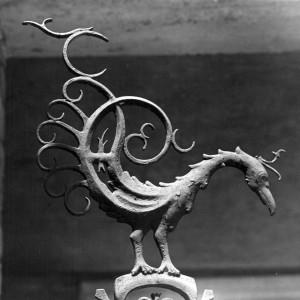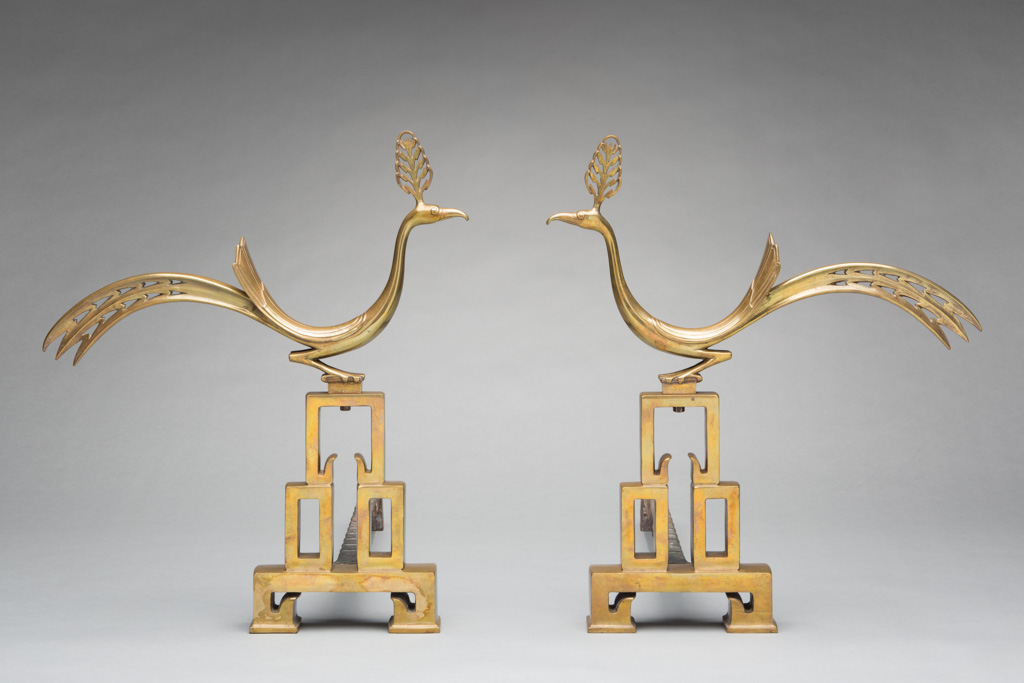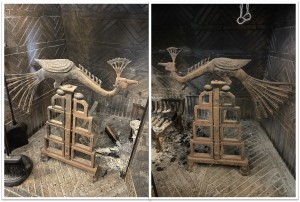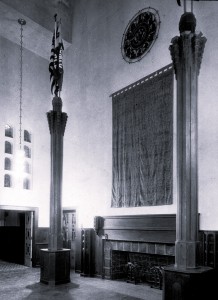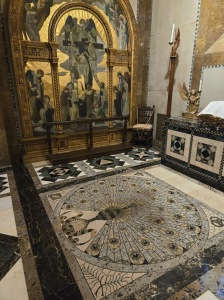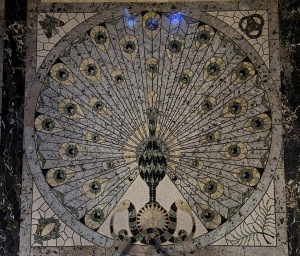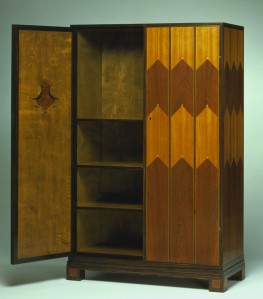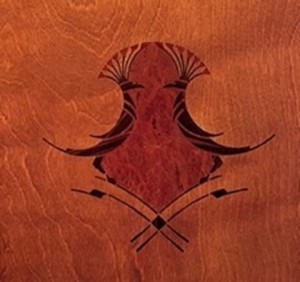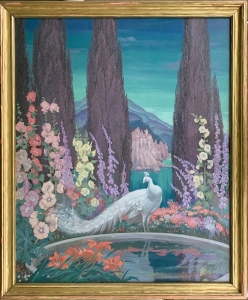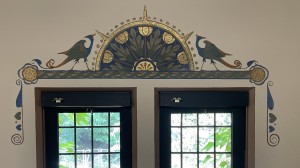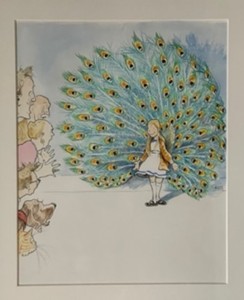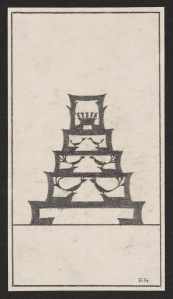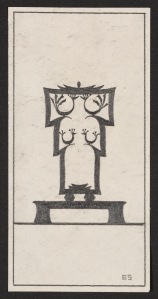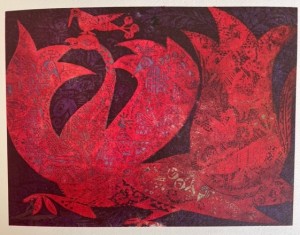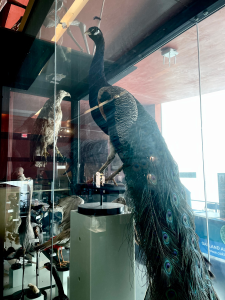While researching the step-backed Peacock Andirons at Saarinen House last spring, I enthusiastically mustered a muster of peacocks from across Cranbrook’s campus with the generous help of my colleagues.
“Muster” is the official label for a group of peacocks.
Unlike a gaggle of geese, a muster of peacocks lacks both onomatopoeia and alliteration and implies a level of formality and regimental order in direct conflict with the species’ behavior! That is…judging by the peacocks I’ve witnessed at historic homes and castles throughout Europe, including a visit to Scone Castle in Scotland where an earlier visitor captured these free-spirited troops. Whether iridescent blue or albino, their graceful necks and distinctive crests rise to magnificence when tail feathers are splayed to attract a peahen mate or intimidate predators.
Throughout the ages, blue aka Indian peafowl have symbolized beauty and prosperity and served as sources of artistic inspiration. A favored theme at Cranbrook, the peacock’s dramatic curvilinear lines are represented at each institution across the campus.
One can discover…
WORKS IN METAL:
• The famed Peacock Gates designed by Finnish-American architect Eliel Saarinen and fabricated in wrought and cast iron by Oscar Bruno Bach, 1927, marking the former Lone Pine Road entrance to Cranbrook School for Boys:
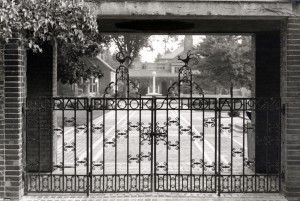
Details of the peacocks in cast iron:
• Eliel Saarinen’s cast bronze Peacock Andirons, 1928-29, on view at Saarinen House. Collection of Cranbrook Art Museum. Produced by Sterling Bronze Company, New York, between 1928 and 1929, these cast bronze andirons were paid for by the Cranbrook Foundation and entered in the 1928-1930 Arts & Crafts Building ledger on pages 40-41—Date: 1-7-30; No.: 515; Name: Sterling Bronze Co; Remarks: 1 pair/ Andirons for Saarinen Res[idence]; Amount: $152.50 (the equivalent of $2,704 in 2024):
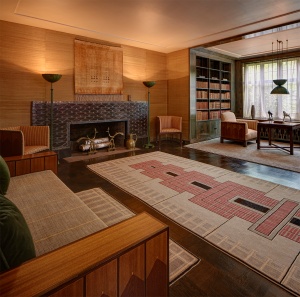
• A second set of peacock andirons designed by Eliel Saarinen, circa 1928, this time for the Cranbrook Boys School Dining Hall, where they remain on view. Crafted by master iron worker John C. Burnett in the Iron Shop of the Cranbrook Foundation’s department of Arts & Crafts, payment to Burnett is listed in the Cranbrook School Record Book 1926-1930, pages 28-29—Date: 10/2/28; No. 751; Remarks: “andirons for fireplace new Dining Hall,” Amount: $375 (roughly $6,649 in 2024):

• A peacock-shaped kohl pot purchased in Lahore, Pakistan in 1956 by Dr. Robert T. Hatt, director of Cranbrook Institute of Science from 1935 to 1967. Fabricated in brass with colored stones, this pot would traditionally have held kohl eyeliner, a mixture of ground stibnite minerals and fat. Collection of Cranbrook Institute of Science:
WORKS IN FIBER:
• Rug No. 2, designed by Loja and Eliel Saarinen and handwoven and knotted by Studio Loja Saarinen: Loja Saarinen and Walborg Nordquist Smalley, 1928-29, utilizing the traditional Scandinavian ryijy technique in cotton and wool. Now in the collection of Cranbrook Art Museum:

• A peacock-themed wall hanging designed by Loja Saarinen, woven by Studio Loja Saarinen, circa 1932, and displayed in Eliel Saarinen’s A Room for a Lady at The Metropolitan Museum of Art’s “Contemporary American Industrial Art” exhibition in 1934 and again in the “Exhibition of Home Furnishings” at the Cranbrook Pavilion in 1935. Now in the collection of Cranbrook Art Museum:

WORK IN CERAMIC:
• Pewabic tiles in the form of a peacock purchased from the Society of Arts and Crafts, Detroit, Michigan for $29 and installed on the east exterior of the Boat House at Kingswood Lake, 1917:
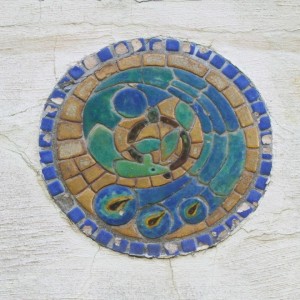
WORK IN STONE:
• A dramatic peacock gracing the marble floor of the Chapel of the Resurrection at Christ Church Cranbrook. Consecrated in 1928, the church was part of Cranbrook Educational Community until 1973:
WORK IN WOOD:
• Inlaid peacocks on the interior door panel of a cabinet or bookcase designed by Eliel Saarinen and fabricated on campus by Tor Berglund, 1929-30. Wood frame with greenheart, African walnut, rosewood, maple, birch, burl, and mahogany veneers. Collection of Cranbrook Art Museum:
WORKS IN PAINT:
• An albino peafowl designed by Pipsan Saarinen Swanson, one of her many painted decorations embellishing the wood shutters in the Upper Dining Hall at Kingswood School for Girls, 1931:

• Another albino peacock appears in The Mirror, painted in oil on canvas by Jesse Arms Botke, 1926. This painting was likely purchased by Cranbrook’s founders George Gough Booth and Ellen Scripps Booth for their own home, Cranbrook House, and currently hangs on the second floor:
• A painted wall stencil by Katherine McEwan above the east windows of Brookside Meeting House, circa 1918:
WORKS ON PAPER:
• Original artwork in ink, watercolor, and pastel for Imogene’s Antlers by award-winning children’s book author and illustrator David Small, 1985. Small’s page-turning depiction of Imogene with peacock tail feathers is on display at the lower-school library at Brookside School:
• Four Eliel Saarinen sketches of proposed peacock andirons for Cranbrook School for Boys, circa 1929, gifted to Cranbrook Art Museum by Loja Saarinen:
• Peacock Festival: Selected Color Woodcuts by József Domján, in the collection of Cranbrook Academy of Art Library, stands out among the peacock-related books housed within the eight-or-more libraries across campus. Vying with Domján’s other books on the Academy’s shelves, this 1962-1964 international exhibition catalogue is devoted entirely to peacocks, including a print of Fire Peacock and its companion poem of the same name penned by Ruth Laurene, whose work is included in a number of Domján’s books:
• A peacock menu cover preserved by Henry Scripps Booth, dated July 1, 1960, from a cross-Atlantic voyage on the RMS Queen Mary—a flagship of the Cunard Line from 1936 to 1967. Now in the collection of Cranbrook Archives:
A SCIENTIFIC SPECIMEN:
• An Indian peacock on view in the ornithology case at Cranbrook Institute of Science.
Still want more peacocks? Don’t despair.
The peacock has been a wildly popular motif in literature, fashion, and the decorative and fine arts throughout history, peaking during the Art Nouveau and Art Deco periods.
A masterful muster of peacocks awaits you. Strut on!
– Diane VanderBeke Mager, Collections Interpreter, Cranbrook Center for Collections and Research
Discover more from Cranbrook Kitchen Sink
Subscribe to get the latest posts to your email.
